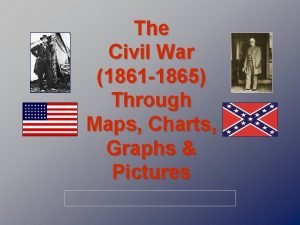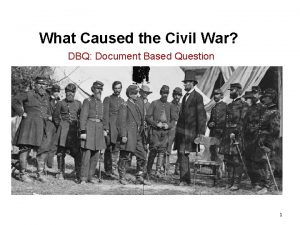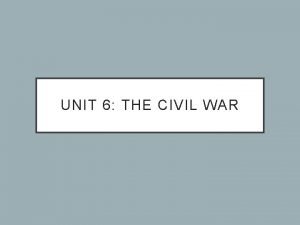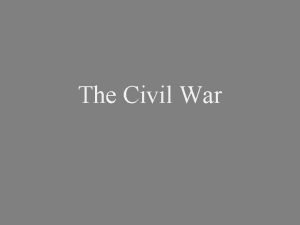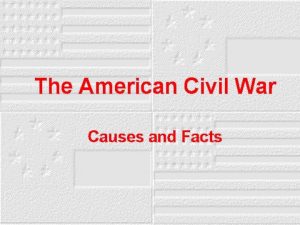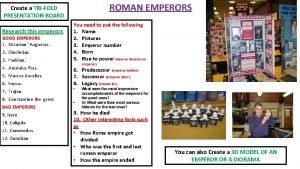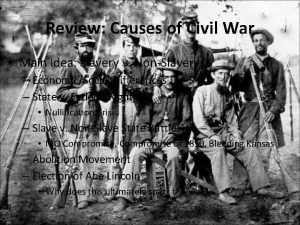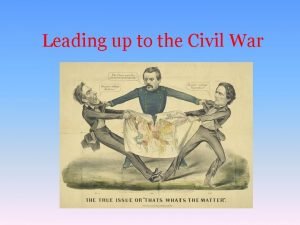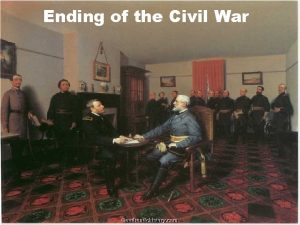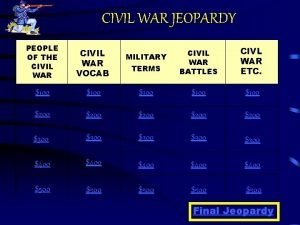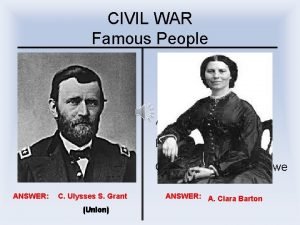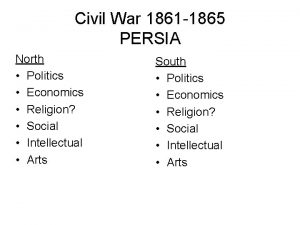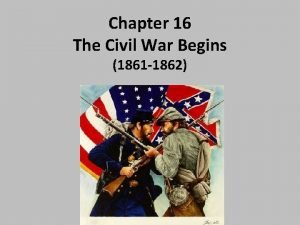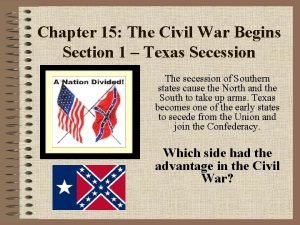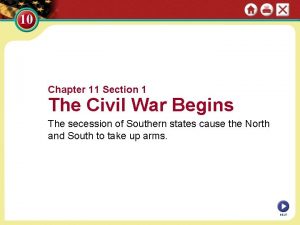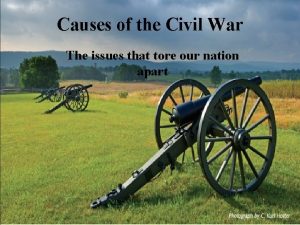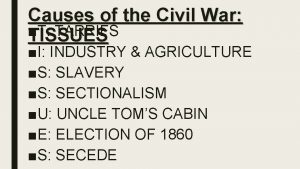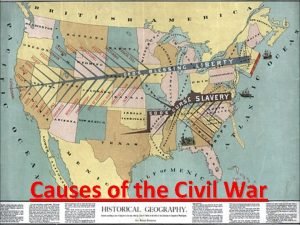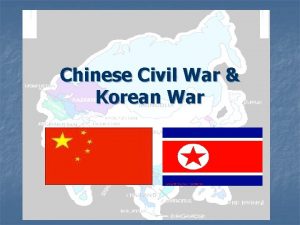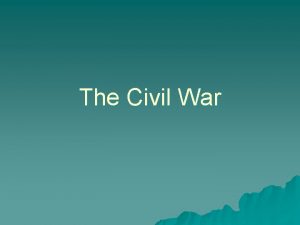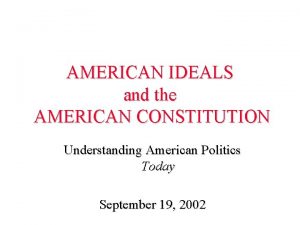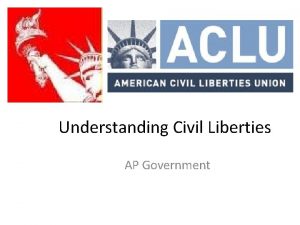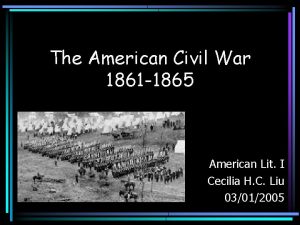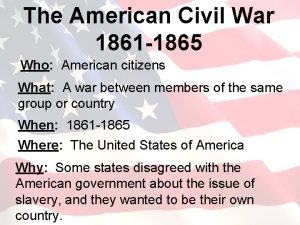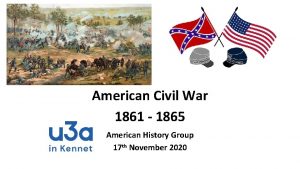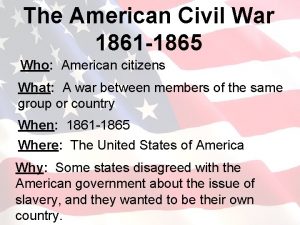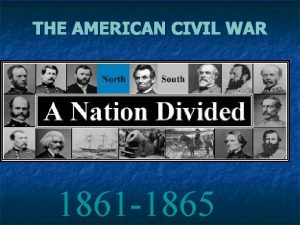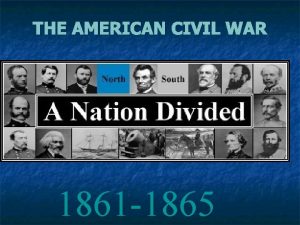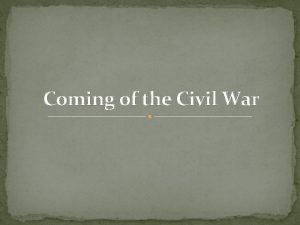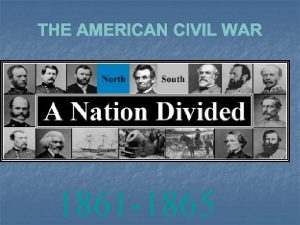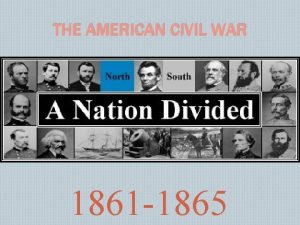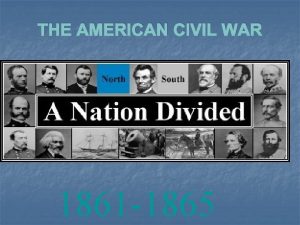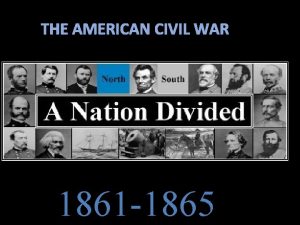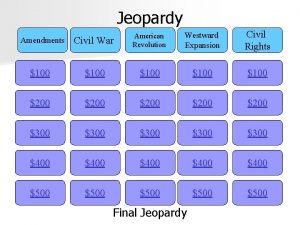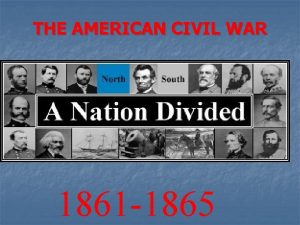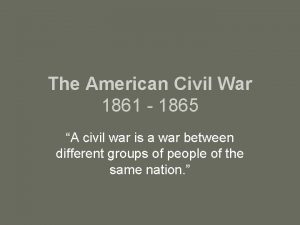The Civil War Understanding the American Civil War


































- Slides: 34

The Civil War Understanding the American Civil War from start to finish 1800 to 1865

Objectives • Understand the causes that led to the American Civil War • Understand events that led up to the American Civil War • Understand the differences between the North and South that lead to Civil War • Understand why the North was able to achieve victory in the American Civil War

In 1776, the American colonists decided to declare their independence from England. Thomas Jefferson, a young lawyer from Virginia, was asked to write a Declaration of Independence to inform the English and other nations about this decision. In the Declaration, Jefferson wrote. . . We hold these truths to be self-evident… that all men are created equal. . .

But in spite of Jefferson’s words, not all Americans were equal. In fact, about 1/5 of all the people in America were slaves. The question of slavery would haunt America throughout its history.

After the Revolutionary War was won, the founders gathered to draft a Constitution to form a new government. Here, questions about slavery came up and arguments broke out. .

It became clear that the Southern states would never join the new United States of America if slavery were outlawed by the Constitution. Both sides made compromises about slavery to try to unite the states. The issue of slavery was finally left open. . . an issue that future generations would have to deal with.

Throughout the early 1800 s people in the Northern states voiced their beliefs that slavery should be abolished. They were called abolitionists. The abolitionist movement grew. Every time a new state wanted to join the union, big arguments broke out about whether the state should be a free or slave state. Things were getting worse between the Northern and Southern states.

The Southern states pressured the federal government to pass stronger laws for the capture of runaway slaves. In 1857 the Supreme Court decided a case of a runaway slave named Dred Scott was suing for his freedom, but the court held that the Constitution protected slavery and that African Americans were not citizens protected by the Constitution. This decision made the abolitionists very angry. It left no room for compromise.

The nation was pushed closer to civil war. Then, in 1860, Abraham Lincoln was elected President. . . by the Northern state Electoral Map of 1860. Lincoln carried red states. This caused most of the Southern states to leave the Union.

Sectional Differences Issues Economic Factors North • Agriculture & industry • Immigrant labor South • Agriculture • Slave labor Slavery Issue • Abolitionists • Pro-slavery • Favored entry of free • Favored entry of slave states Compromise of 1850 • California admitted as a free state • Slave trade abolished • Utah and New Mexico Territories opened to slavery The Election of Lincoln • Supported by North and West • Alienated the South

Economic Issues- North • North had a diverse economy with agriculture and growing factories and industry • North had a growing immigrant population attracted by factory jobs (+3. 5 million in 1850 s) • North was building infrastructure to support industry – Railroads, canals

Economic Issues- South • Southern economy was based on agriculture. Cotton, Rice, Tobacco • Southern plantations were kept going through Slavery • South had little infrastructure- relied on rivers to transport goods • More than 2/3 s of Southerners lived on small farms w/o slaves • Most Southerners believed that slavery was essential to their economy and way of life

Road to War • Missouri Compromise (1820) -- Maine admitted as a free state and Missouri as a slave, but no other slave states from the Louisiana Purchase territory would be allowed north of Missouri’s southern boundary

Road to War • Nullification Crisis (1832) -- Responding to a high cotton tariff, South Carolina declares a state can void any act of Congress it feels is unconstitutional

Road to War • Mexican War (1846 -1848) -- viewed by some as a Southern attempt to expand slavery – Wilmot Proviso (1846) fails. Would have formally renounced any intention to introduce slavery into lands seized from Mexico

Road to War (cont) • Compromise of 1850 -- California admitted as a free state; slavery in New Mexico and Utah territories to be determined by popular sovereignty; the prohibition of the slave trade prohibited in the District of Columbia; a more stringent fugitive slave law

Compromise of 1850 • California becomes a free state • End of slave trade in Washington DC • New territories of New Mexico and Arizona would have nor rules against slavery • Fugitive Slave Law issued – Slaves equal property and must be returned

Kansas-Nebraska Act 1854 • • • Split the Nebraska territory in two Nebraska in the North free territory Kansas in the South would get to vote on it Violence broke out in Kansas over this Even in Congress-

Senator Brooks (S. Carolina) beat Senator Sumner (Mass) with a cane over the issue

Election of Lincoln • Democratic party was spilt into factions between North and South • Whig party took votes from Democrats • Lincoln wins the 1860 presidential election • Lincoln was not even on the ballot on 10 Southern states • With his election South Carolina succeeds from the Union 12/20/1860


The War • 1861 December South attacks Fort Sumter in South Carolina • A couple battles happened • The North had more troops and supplies • The South ran out of stuff and couldn’t get foreign help • General Lee surrendered to Gen Grant on April 9, 1865

By April, 1861, war broke out among the Northern and Southern states.

Objectives North • Restore Union – Therefore couldn’t completely alienate or destroy the South or the Southern people • South • Hold on to de facto independence – Continue the struggle long enough for the North to tire of it – Similar to American colonists


Comparison North • 20 million people • 110, 000 manufacturing establishments • 22, 000 miles of railroad • 75% of nation’s total wealth • 16, 000 man Army and 90 ship Navy South • 9 million people (over 4 million slaves) • 18, 000 manufacturing establishments • 8, 500 miles of railroad • Wealth lay in land slaves (non-liquid) • No existing military

Comparison North South • Had to project forces across large and hostile territory • Requirement for offense • Had to maintain supply lines • Fighting to regain preexisting status quo • Could take advantage of interior lines • Could win by only succeeding on the defense • Friendly territory and population • Fighting for homeland independence

After four bloody years of civil war, the South was defeated.

Result of Civil War • Over 618, 000 military deaths • Emancipation of over 4 million slaves • Destroyed old Southern (Antebellum)


Questions following the Civil War • • What to do with former slaves? Should Southerners be punished? What to do with the rebellious states? What impact will this have on the economy of the South? And National economy?

In 1863, President Lincoln issued the Emancipation Proclamation, which freed the slaves in the rebel states.

After the Civil War ended, Congress passes three new Amendments to the Constitution. 13 th Amendment (1865) “Slavery…shall not exist within the United States or any place subject to their jurisdiction. ” Sometimes called the “Civil War Amendments. ” 14 th Amendment (1868) All people born or naturalized in the U. S. are citizens. All citizens must be treated equally under the law. Due process of law for all.

15 th Amendment (1870) Right to vote cannot be denied based on “race, color, or previous…servitude. ”
 Who were abolitionists
Who were abolitionists Why was the civil war the first modern war
Why was the civil war the first modern war Chapter 16 lesson 2 challenges to slavery
Chapter 16 lesson 2 challenges to slavery Civil rights webquest
Civil rights webquest Cuban american civil engineering association
Cuban american civil engineering association What caused the civil war dbq
What caused the civil war dbq Civil war map activity
Civil war map activity The cause of the civil war
The cause of the civil war Gtech gettysburg
Gtech gettysburg Timeline of the english civil war
Timeline of the english civil war What led to the civil war
What led to the civil war Civil war facts
Civil war facts Civil war staar questions
Civil war staar questions Trifold presentation
Trifold presentation Blockade
Blockade Ppt
Ppt Civil war advantages and disadvantages chart
Civil war advantages and disadvantages chart What led to the civil war
What led to the civil war Civil war trading cards project
Civil war trading cards project Unit 4 civil war and reconstruction
Unit 4 civil war and reconstruction What events led to the civil war
What events led to the civil war Civil war map sherman's march to the sea
Civil war map sherman's march to the sea The civil war affected the northern economy by
The civil war affected the northern economy by Civil war and reconstruction study guide
Civil war and reconstruction study guide Causes of the civil war jeopardy
Causes of the civil war jeopardy Jeopardy civil war
Jeopardy civil war Famous people in the civil war
Famous people in the civil war Civil war advantages and disadvantages chart
Civil war advantages and disadvantages chart Civil war resumes
Civil war resumes Chapter 16 the civil war begins worksheet answers
Chapter 16 the civil war begins worksheet answers States rights
States rights Site:slidetodoc.com
Site:slidetodoc.com What were the 4 main causes of the civil war
What were the 4 main causes of the civil war Tissues causes of civil war
Tissues causes of civil war Northwest ordinance lead to civil war
Northwest ordinance lead to civil war
